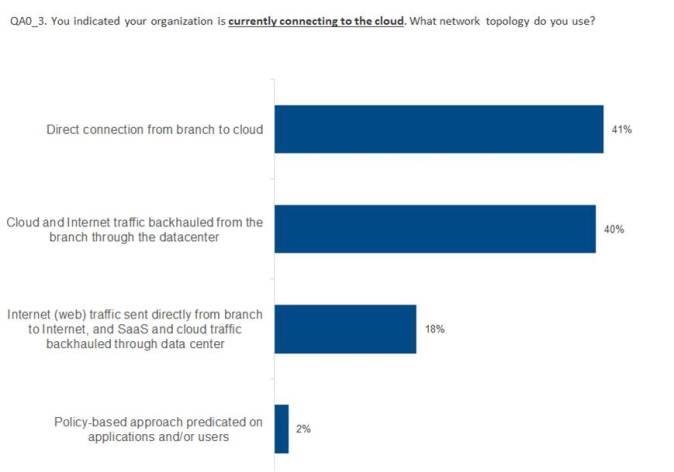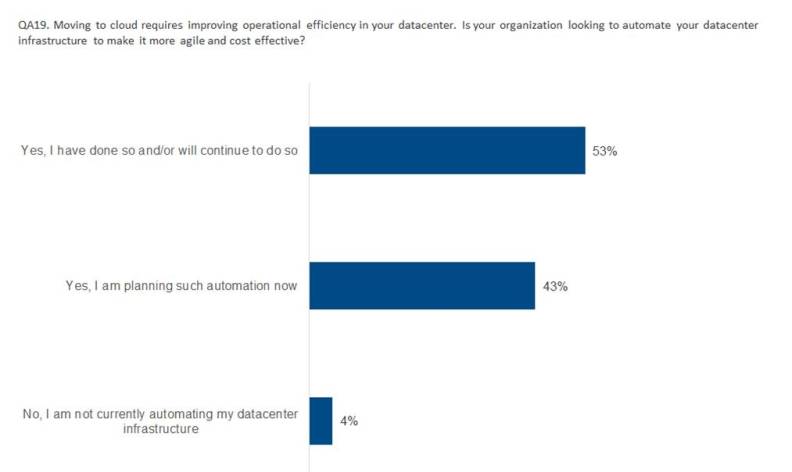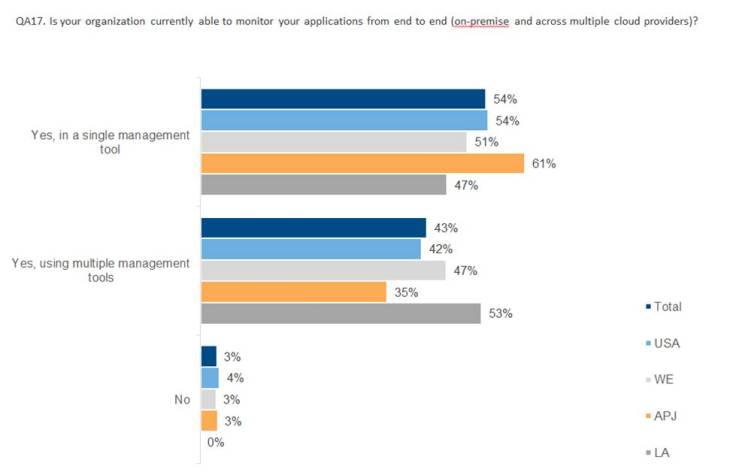94% of large and medium-sized companies are morally ready for the “clouds”. But only 24% can do it right now.
Some time ago, an article about the workplace of the future was published on Habré. It made predictions that most of us would lose literal jobs some day, but any place we choose could become a worker. We will also be swallowed up by virtualization and cloud technologies, and the borders of the office, time zone, or job description will cease to exist.
This text was also interesting because it echoed the research released by IDC. IDC has studied the technology plans of 900 large companies and concluded that 94% of them not only recognize the future of cloud technologies, but are already actively preparing for their implementation: they are reviewing, transforming and modernizing their network infrastructures to simplify application delivery. However, there is one “but” - only 24% of the network infrastructure is fully ready for hybrid cloud applications. All others are only working in this area.
Let's see in which direction they are moving, and what steps they are taking to do this.
')

To begin with, who is in these 900 companies: medium and large-sized firms located geographically in the USA, Europe, Asia and Latin America participated in the survey. Some of them specialize in insurance, some - in financial services, but most have business in other areas.

An interesting fact: the average revenue of these companies is about 300 million dollars a year (less than 5% “earn” 50 million), while the cost of IT infrastructure is about 3 million per year.
As mentioned at the beginning, most companies recognize the future of cloud applications and believe that financial success is waiting for those who adapt their multi-cloud and hybrid architectures for simple and reliable application delivery. However, only 24% of the surveyed firms are ready to move to the cloud right now, 40% believe that their network meets only certain cloud needs, and 36% think that they are not completely ready. But these 76% are already working on correcting the situation.
The next question is: why do all these companies spend money on upgrading their infrastructure and move from the local work model to the concept of “delivering virtual applications directly to the user device through the cloud”? According to the survey, this is done for the sake of:
In other words, most companies want to increase their own security and take highly-paid employees of IT departments with a solution of something important, and not an endless routine.
An important point: companies understand that these benefits can be obtained only by abandoning the processes and work methods that they used for traditional data centers. And since many branded applications need to be either upgraded or rewritten for the cloud from scratch (there is another option - to buy a ready-made solution in the form of SaaS), now there is an excellent chance to abandon some of the legacy programs, which the IT department should only drag on their shoulders because so historically.
Network topology: most companies prefer to connect their branches directly to the cloud or drive traffic through their own data center:

Another interesting fact: almost 70% of respondents - the overwhelming majority - have two or three ways to remotely access their data centers or the cloud.
What companies invest money in: despite a large percentage of ready-made SaaS applications, companies are not very inclined to trust them. First of all, due to the need to create a single, secure login to applications, due to the impossibility of influencing cloud performance and the lack of tools to control user activity. Therefore, many companies invest in the development of their own cloud applications and are willing to spend money on upgrading data centers

In addition, the majority of the company advocates a unified tool for managing virtual applications and is working to bring all disparate tools into one platform.

The arrival of cloud technologies is unstoppable, and most large and medium-sized companies in the world understand this. The transition to the delivery of applications allows not only to unload IT-divisions (the allocation of resources can be done with a few mouse clicks instead of deploying a local server) and switch them to important strategic tasks, but also significantly enhance their own security.
But one cannot come to a bright future with the computer baggage that companies have been carrying for years. Therefore, most of them are working on upgrading existing programs or rewriting them from scratch. And here it is very important to assess the need for interaction with other applications, consider how to use the data and check the availability of application programming interfaces that will simplify workflows.
This text was also interesting because it echoed the research released by IDC. IDC has studied the technology plans of 900 large companies and concluded that 94% of them not only recognize the future of cloud technologies, but are already actively preparing for their implementation: they are reviewing, transforming and modernizing their network infrastructures to simplify application delivery. However, there is one “but” - only 24% of the network infrastructure is fully ready for hybrid cloud applications. All others are only working in this area.
Let's see in which direction they are moving, and what steps they are taking to do this.
')

To begin with, who is in these 900 companies: medium and large-sized firms located geographically in the USA, Europe, Asia and Latin America participated in the survey. Some of them specialize in insurance, some - in financial services, but most have business in other areas.

An interesting fact: the average revenue of these companies is about 300 million dollars a year (less than 5% “earn” 50 million), while the cost of IT infrastructure is about 3 million per year.
As mentioned at the beginning, most companies recognize the future of cloud applications and believe that financial success is waiting for those who adapt their multi-cloud and hybrid architectures for simple and reliable application delivery. However, only 24% of the surveyed firms are ready to move to the cloud right now, 40% believe that their network meets only certain cloud needs, and 36% think that they are not completely ready. But these 76% are already working on correcting the situation.
The next question is: why do all these companies spend money on upgrading their infrastructure and move from the local work model to the concept of “delivering virtual applications directly to the user device through the cloud”? According to the survey, this is done for the sake of:
- Increase IT efficiency (universal virtual machines with a minimum of maintenance costs);
- reducing the risk of any potential security breaches (including by eliminating shadow user networks with low or absent security policies);
- release of IT staff for more important strategic tasks.
In other words, most companies want to increase their own security and take highly-paid employees of IT departments with a solution of something important, and not an endless routine.
An important point: companies understand that these benefits can be obtained only by abandoning the processes and work methods that they used for traditional data centers. And since many branded applications need to be either upgraded or rewritten for the cloud from scratch (there is another option - to buy a ready-made solution in the form of SaaS), now there is an excellent chance to abandon some of the legacy programs, which the IT department should only drag on their shoulders because so historically.
Network topology: most companies prefer to connect their branches directly to the cloud or drive traffic through their own data center:

Another interesting fact: almost 70% of respondents - the overwhelming majority - have two or three ways to remotely access their data centers or the cloud.
What companies invest money in: despite a large percentage of ready-made SaaS applications, companies are not very inclined to trust them. First of all, due to the need to create a single, secure login to applications, due to the impossibility of influencing cloud performance and the lack of tools to control user activity. Therefore, many companies invest in the development of their own cloud applications and are willing to spend money on upgrading data centers

In addition, the majority of the company advocates a unified tool for managing virtual applications and is working to bring all disparate tools into one platform.

findings
The arrival of cloud technologies is unstoppable, and most large and medium-sized companies in the world understand this. The transition to the delivery of applications allows not only to unload IT-divisions (the allocation of resources can be done with a few mouse clicks instead of deploying a local server) and switch them to important strategic tasks, but also significantly enhance their own security.
But one cannot come to a bright future with the computer baggage that companies have been carrying for years. Therefore, most of them are working on upgrading existing programs or rewriting them from scratch. And here it is very important to assess the need for interaction with other applications, consider how to use the data and check the availability of application programming interfaces that will simplify workflows.
Source: https://habr.com/ru/post/341310/
All Articles